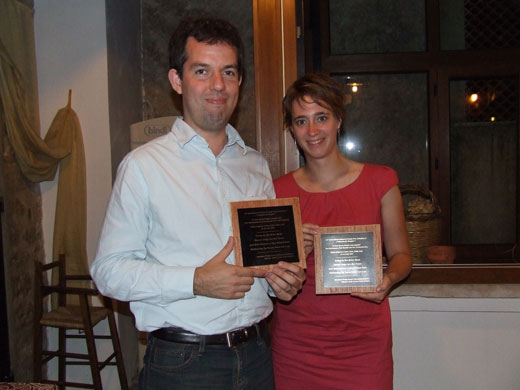
At this year’s 18th International School of Cosmic Ray Astrophysics in Erice, Italy, IceCube graduate students Anne Schukraft, RWTH Aachen University, and Marcos Santander, University of Wisconsin-Madison, were recognized for their analysis and presentations.
Schukraft presented on “Search for a diffuse flux of astrophysical muon neutrinos with the IceCube detector” and Santander on “Anisotropy of TeV and PeV cosmic rays with IceCube and IceTop.”
This is the first time the informal awards were handed out, and they were inscribed with a short poem:
“Today in the Erice maze
Cosmic Rays are the craze
and this because a guy named Hess
ballooning up found more not less.”
The poem, which can be found on a plaque mounted on the wall of the Secretariat room in the Ettore Majorana Centre in Erice, references Victor Hess, the Austrian physicist who discovered cosmic rays in 1912.
The theme of this year’s International School of Cosmic Ray Astrophysics was “A new Era in Particle Astrophysics: New Instruments, New Results and New Understanding.” IceCube principal investigator Francis Halzen, University of Wisconsin-Madison, and Subir Sarkar, University of Oxford, served as lecturers during the school.
Other IceCube collaboration members participating in the school included Jacob Feintzeig, University of Wisconsin-Madison, and Bakhtiyar Ruzybayev, University of Delaware.
For more information about the 18th International School of Cosmic Ray Astrophysics, visithttp://laspace.lsu.edu/ISCRA/ISCRA2012/index.php
At this year’s 18th International School of Cosmic Ray Astrophysics in Erice, Italy, IceCube graduate students Anne Schukraft, RWTH Aachen University, and Marcos Santander, University of Wisconsin-Madison, were recognized for their analysis and presentations.
Schukraft presented on “Search for a diffuse flux of astrophysical muon neutrinos with the IceCube detector” and Santander on “Anisotropy of TeV and PeV cosmic rays with IceCube and IceTop.”
This is the first time the informal awards were handed out, and they were inscribed with a short poem:
“Today in the Erice maze
Cosmic Rays are the craze
and this because a guy named Hess
ballooning up found more not less.”
The poem, which can be found on a plaque mounted on the wall of the Secretariat room in the Ettore Majorana Centre in Erice, references Victor Hess, the Austrian physicist who discovered cosmic rays in 1912.
The theme of this year’s International School of Cosmic Ray Astrophysics was “A new Era in Particle Astrophysics: New Instruments, New Results and New Understanding.” IceCube principal investigator Francis Halzen, University of Wisconsin-Madison, and Subir Sarkar, University of Oxford, served as lecturers during the school.
Other IceCube collaboration members participating in the school included Jacob Feintzeig, University of Wisconsin-Madison, and Bakhtiyar Ruzybayev, University of Delaware.
For more information about the 18th International School of Cosmic Ray Astrophysics, visit http://laspace.lsu.edu/ISCRA/ISCRA2012/index.php
